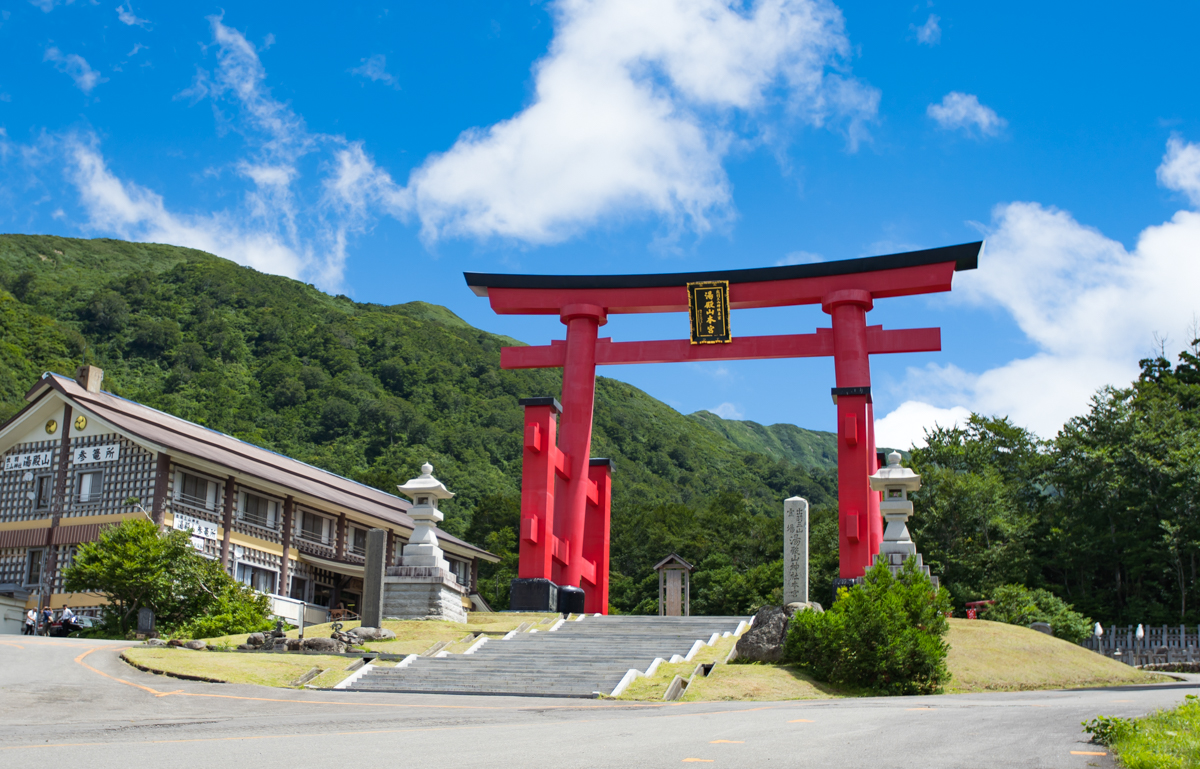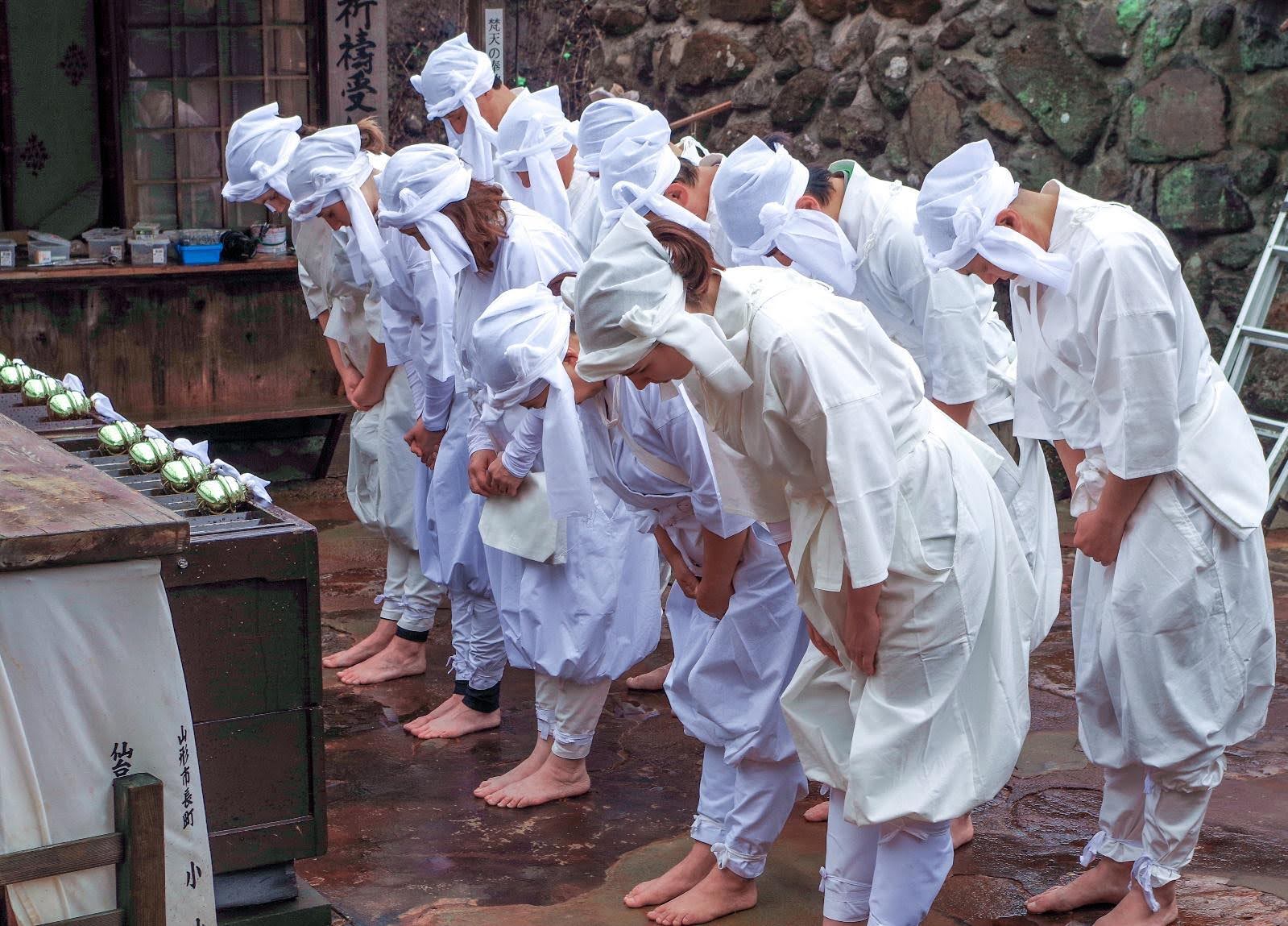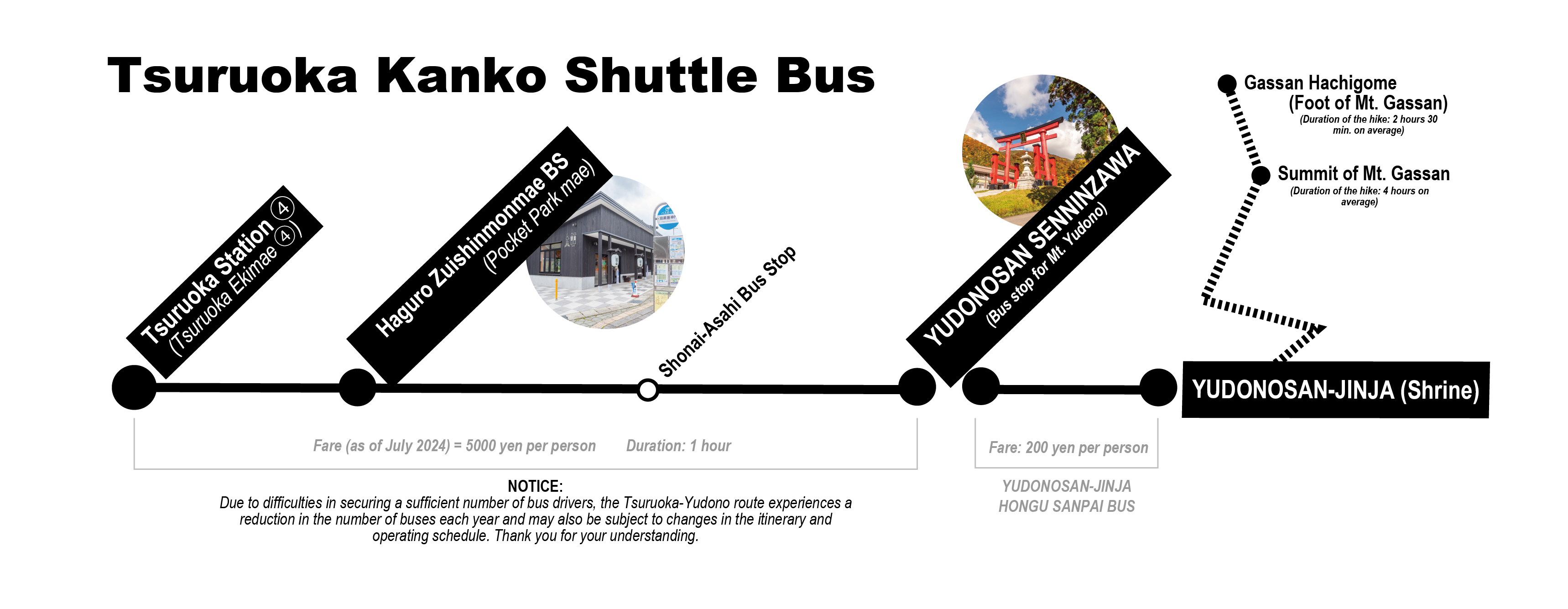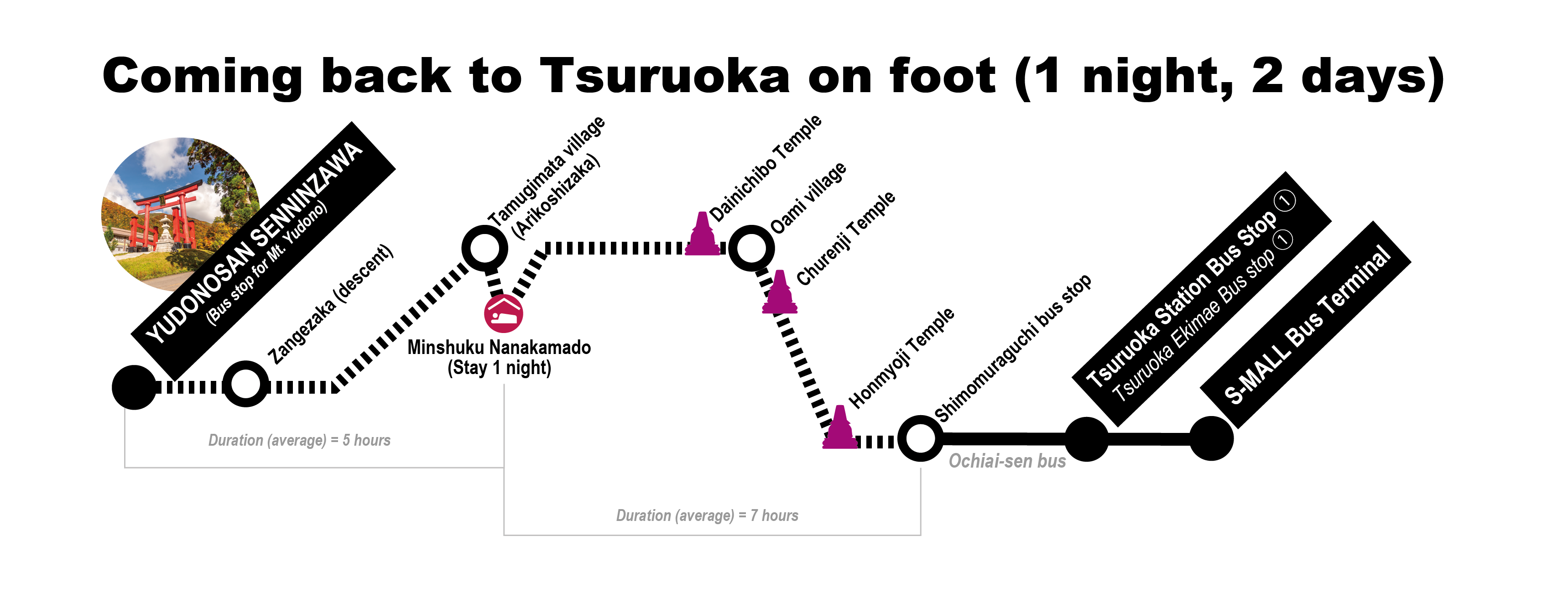Mt. Yudono

Mt. Yudono is the most mysterious of the Dewa Sanzan. For centuries it was forbidden for anyone who knew of its existence to speak of it. Even today, although the existence of the mountain is widely known, it is forbidden for those who visit to describe to others what they see or encounter there. Being a divine realm, the innermost area of Mt. Yudono has remained symbolically untouched by human construction, with no permanent structures built.
Representing rebirth and the future, Mt. Yudono is traditionally the final mountain visited on a Dewa Sanzan pilgrimage, symbolizing a rebirth within the same realm of existence. Sokushinbutsu, monks who underwent a severe regimen to mummify themselves while still alive, are primarily associated with the Yudono sect of Shingon Esoteric Buddhism.
Origins
The spiritual origins of Mt. Yudono are shrouded in mystery. According to the history recorded by the Dewa Sanzan Shrine, Mt. Yudono was consecrated by Prince Hachiko after his discovery of Mt. Gassan. According to the principal Buddhist temples of Mt. Yudono—Churenji, Dainichibo, and Hondoji—it is said that Mt. Yudono was consecrated by Kukai, the founder of Shingon Buddhism, himself.
Sometime between the late 16th century and early 17th century, Mt. Yudono took its place in the Dewa Sanzan trio of holy mountains. It replaced Mt. Chokai, the former third mountain of the Dewa Sanzan. Mt. Yudono was in the same mountain range as Mt. Haguro and Mt. Gassan, whereas Mt. Chokai stood alone some hundred kilometers to the north. Substituting Mt. Yudono for Mt. Chokai made it easier for worshippers to complete a pilgrimage. Though geographically near Mt. Haguro and Mt. Gassan, Yudono was staunchly Shingon and thus had little in common spiritually with the rest of the Dewa Sanzan. Nevertheless, Mt. Yudono’s temples agreed to be designated as part of the Dewa Sanzan as they thought it would not be detrimental to them. The location of the mountain was no longer shrouded in secrecy, and overflowed with pilgrims. In 1733, the administration recorded 157,000 pilgrims who visited the mountain. In 1873, five years after the new Meiji government’s shinbutsubunri proclamation (the enforcement of religious segregation between Shinto and Buddhism), the sacred site at the peak of Mt. Yudono was forcefully converted to Shinto, despite the ferocious opposition from the mountain’s principal temples Churenji and Dainichibo.
The Yudono faith
Mt. Yudono is a center of Shingon Buddhism, an esoteric sect of Buddhism founded by the monk Kukai (aka Kobo Daishi, 774-835). In Shingon Buddhism, the supreme Buddha-body Dainichi Nyorai (aka Vairocana) is believed to embody the entire universe and incarnate universal truth. In Kukai’s Shingon Buddhism, followers are taught how to “become a Vairocana Buddha” by reciting Vairocana’s words. According to Kukai, everybody can become a “Buddha” in their present life. This concept is called sokushinjobutsu (即身成仏), and is attainable through enlightenment and esoteric training.
Sokushinbutsu
As it was practiced on Mt. Yudono, the concept of sokushinjobutsu eventually took on a concrete form: the practice of sokushinbutsu, self-mummification. Of the twenty extant sokushinbutsu mummies in Japan, eleven of them were monks who trained on Mt. Yudono. Eight are enshrined in Yamagata Prefecture—four in Tsuruoka and two in Sakata. A replica sokushinbutsu sits in a tiny hut on Mt. Yudono, marking the spot where the real sokushinbutsu mummy was unearthed.
Points of Interest
Yudonosan Shrine

Being a divine realm, the innermost area of Mt. Yudono has remained symbolically untouched by human construction. At the entrance to the sacred site, a priest guides visitors through a brief hitogata purification ritual to cleanse one of defilements before being permitted in any deeper.
Enshrined Deities
| Deity name | Associated religion | Blessings bestowed |
| Dainichi Nyorai (大日如来, Vairocana) | Buddhist | Attainment of Buddhahood in one’s living body |
| Oyamatsumi no Kami (大山祗神) | Shinto | Longevity, Business prosperity, Family safety, Good fortune in relationships, Safe childbirth, Water source management |
| Ōanamuchi no Mikoto (大巳貴命) | Shinto | Romantic connections, Marital harmony, Safe childbirth, Abundant harvests, Business prosperity, Protection from misfortune, Good fortune in life |
| Sukuna-hikona no Kami(少彦名神) | Shinto | Healing from illness, Good health |
Yudonosan Senninzawa

Yudonosan Senninzawa served as the cradle of the Yudonosan-kei Sokushinbutsu (mummies of monks who underwent training at Mt. Yudono). Today, a paved road crosses the area, but pilgrims traditionally had to cross its sacred river in a ritual known as Osawa-gake (御沢駆け) to reach the holy deity at the summit. This journey typically took around 2 hours via the traditional path, while walking up the paved road takes 30 minutes, and only 8 minutes by bus.
Monks aiming to become sokushinbutsu had to endure at least 1,000 days in Senninzawa, often enduring harsh, snowy winters over several years. Crossing the holy river in winter posed significant risks, including avalanches and hypothermia. Many disciples did not survive this rigorous training. The disciples had to overcome extreme cold and the strenuous physical effort of daily snow removal. Because of the dangers associated with the holy crossing of the river, DO NOT attempt without the guidance of a Yamabushi guide.
Yudonosan Senninzawa is marked by a giant torii gate. To the left stands the Yudonosan Sanrojo Pilgrim Lodge, slightly further down on the left is the Yudonosan Resthouse, where visitors can enjoy lunch and purchase souvenirs. To the right lies the Mt. Yudono Graveyard, featuring a commemorative stone dedicated to the Yudonosan-kei Sokushinbutsu.
Access


Bus Timetable and Information
Shuttle buses to Mt. Yudono (bus stop: Yudonosan Senninzawa 湯殿山仙人沢) are operated by the local bus company Shonai Kotsu. However, due to its distance from central Tsuruoka City (45 km, approximately 50 minutes to 1 hour by car), the company faces challenges in securing enough drivers and funding to run daily services. This issue has been worsening over the years, resulting in fewer buses operating to Mt. Yudono each year.
In recent years, the Yudonosan Senninzawa bus service has been available only on weekends, national holidays, and during an extended period over the summer holidays. For up-to-date information, please check Shonai Kotsu’s timetable on their Japanese website: Shonai Kotsu Website.
Given the limited bus schedule, planning your trip to Dewa Sanzan around the bus operating days for Mt. Yudono may not be practical. Instead, we recommend the following three alternative solutions:
Private Hire
This is the most expensive but also the most convenient option. It allows you to travel without being restricted by the bus schedule and gives you the flexibility to choose your exact pick-up and drop-off points. However, most taxi companies only communicate in Japanese, and making a reservation without the help of a travel agent can be challenging for non-Japanese speakers.
Cost for a ride (up to 4 people, per group): 18,000 yen
Reservation request form: Shoko Travel Inquiry
Semi-Private Hire
This option is a great compromise for those needing to return to Tsuruoka outside of the bus operating schedule. Semi-private hire services are offered by Shoko Travel, using 4-person taxis. Prices start at 4,000 yen per person for groups of 2 or more. The ride may be shared with another party traveling at the same time.
Please note that the pick-up and drop-off locations are fixed and cannot be adjusted. Reservations must be made at least one day in advance, with a cutoff time of 1:00 PM on the day before your planned travel.
More information: Shoko Travel Tsuruoka Kanko Line.
By Foot
The front entrance to Yudono Shrine is accessible via the Rokujuri-goe Kaido (六十里越街道, English website here: https://www.asahi-kankou.jp/english.html ) trail. The shrine is also accessible from the rear via a pilgrimage trail from Mt. Gassan. For safety reasons, do not attempt the Gassan—Yudonosan pilgrimage trail without a guide.
Mount Yudono Toll Road Details
Operating Hours:
- June 1 — Mid-July and Late August — November 3:
8:15 AM — 4:20 PM*
*Entrance gate closes at 3:50 PM - Mid-July — Late August (exact dates vary by year):
8:15 AM — 5:10 PM*
*Entrance gate closes at 4:40 PM
Location of Tollbooth:
Yamagata Prefecture, Tsuruoka City, Tamugimata Aza Rokujurigami, 10
Google Maps Pin
Official Web Page:
Shonai Kotsu – Mt. Yudono Toll Road

